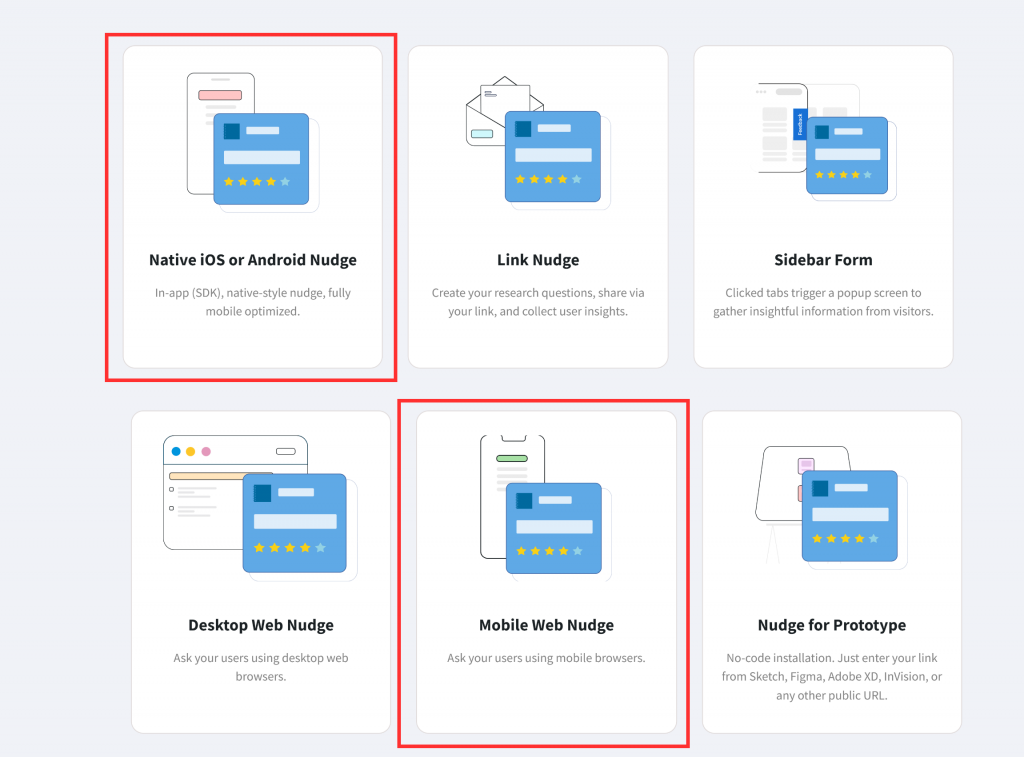It doesn’t matter how awesome your product is or if you offer the best-in-the-biz user experience; long surveys are not customers’ cup of tea.
You can’t expect a high response rate on your surveys if they demand a chunk of user time. More so, surveys with random questions without aim make the matter worse.
So, how to get the ball in your court i.e., encourage users to leave their precious feedback through surveys?
TADA!
Introducing Microsurveys.
Let’s not waste a second more and jump straight to the point.
What Is a Microsurvey?
Microsurveys or pop-up surveys are short-form surveys consisting of 2-3 questions. These surveys effectively collect in-context customer feedback since they focus on one aspect at a time.
They are displayed on-site and in-app to collect real-time insights from visitors and app users.
Microsurveys pop up on the screen in a non-intrusive way to collect customer experience as a whole (for instance, to gauge customer satisfaction or NPS) or insights, for instance, feedback on the UI design of certain pages, product features, etc.
Related read: How To Create Popup Surveys Your Visitors Can’t Resist
Microsurveys vs. Traditional Surveys: Which Is Right for You?
A mere definition is not enough to distinguish micro surveys from traditional surveys, so let’s check out this comparison table below:
| Parameters | Microsurveys | Traditional Surveys |
| Objective | The bite-sized format of the surveys allows businesses to collect responses in real time. You can collect in-moment feedback with laser-focused questions. They are great for pulse-checking customers. |
Helps you understand customer experience by collecting customer feedback on various elements at once. These surveys are used to collect customer insights on different channels. |
| No. of questions | 2 to 3 | Can add as many as you require |
| Response Time | Fast responses with short-deployment time. | When you send surveys through emails and SMS, users are likely to take some time to respond. |
| Modes of Conduct | In-app, On-site | URL links, Email links, SMS |
| When to use | When you want to collect online instant feedback on specific elements. | When you want to drill down on customer pain points and experience in detail. |
Traditional surveys still have their place in your customer experience strategy. It’s just that they have a different role to play based on your business needs.
Benefits of Microsurveys: Why Choose Them Over Traditional Surveys
From the comparison table above, it’s understood that these micro surveys are really effective, quick, and just awesome. But there is still much to discuss regarding the benefits of micro surveys. So, let’s have a look.
Contextual Feedback With Advanced Targeting
Collecting in-context insights is only possible when you can target customers based on attributes. For example, you should be tracking a visitor’s time on a page to ask them what they think needs improvement.
Tools like Qualaroo survey software come with advanced targeting that enables you to show pop-up microsurveys at a specific time, frequency, and when certain conditions are met.
For example, a micro survey will only appear once a customer has spent 30 seconds on the website.
😀FUN INSIGHT!
Qualaroo also sends targeted NPS microsurveys to the users once they have used the product for a specific time using advanced targeting.
CASE STUDY: HOOTSUITE – Minimizing Bounce Rate on Webpages
HootSuite is a social media management tool enabling users to manage social media accounts from several platforms on a single dashboard. It had a huge bounce rate on its home page, and the team wanted to get down to the button and improve it.
Hootsuite leveraged Qualaroo’s pop-up micro survey Nudges™ on the landing page and discovered that it wasn’t new visitor-friendly. As in, it lacked basic information about the platform and only hailed its premium and complex features.
The team analyzed the feedback and decided to overhaul the homepage to align it with customer needs. Here’s how it turned out –
You might be interested in: 60+ Popup Survey Questions to Ask Your Visitors & Customers (2022)
Creates a Feedback Loop Between Users and Business
Product-led marketing and A/B testing without customer feedback can only take your business so far. Pop-up micro surveys enable companies to create a feedback loop where no unsatisfied experience goes unnoticed, and every piece of feedback is assessed and addressed.
This way, your company can close the empathy gap – what businesses think they deliver and what customers think they get.
Bonus read: A Complete A/B Testing Guide With Examples: What & How It Works
Real-Time and Low-Effort Feedback
Unlike long-form surveys you send via email and SMS links, microsurveys are hands-on and can collect real-time feedback.
The time between the survey deployment to collecting and analyzing responses is very short, allowing businesses to get cracking at customer pain points instantly.
More so, since microsurveys contain only 2-3 questions (including open-ended and close-ended), they don’t take much time and effort for customers to respond, resulting in a high response rate.
Qualaroo’s in-context surveys typically achieve higher rates (10-30%) due to their immediate placement within the user experience.
CASE STUDY: ART.com – Understanding Customers’ Pain Points
ART.com uses AR technology to assist customers in buying art online. The team wanted to understand how the product works in the real world and what roadblocks users face while using the platform.
Here’s how it went in the words of Ajantha Suriyanarayanan, Director of Consumer Insights for Art.com —
How to Use Microsurveys? [With Effective Questions]
You know the benefits of deploying microsurveys, but there is more to it. You need to know where and when to leverage these surveys to improve your customer experience.
Keeping that in mind, we’ve segregated the effective microsurvey questions into customer journey touchpoints, so you know when to ask which questions. Here we go:
Lead Generation
In the lead generation stage, your prospects come pouring in and interact with your business by browsing your website or checking out your mobile app.
You have quality leads in the funnel, but they still haven’t made a purchase. They may be browsing the product pages, adding products to the cart but are about to abandon, or have downloaded your app but haven’t bought the subscription.
That’s when you need to know what they think.
Microsurveys are useful in your lead generation process. Here are some ways you can use them:
1. Collect feedback from the leaving visitors: You can conduct exit-intent surveys and target them to appear when a visitor is about to leave the website.
These microsurveys are great for collecting insights from prospects who want to abandon your website without ever turning into a customer and combat cart abandonment and churn.
Here are some questions you can ask:
- If you don’t plan to make a purchase today, can you tell us why not?
- There are still items left in your cart. Is there anything preventing you from completing your purchase?
- Is our pricing clear?
- Did you find what you were looking for?
- Do you need additional information about the [product]?
Bonus read: 11 Best Exit-Intent Popup Tools to Increase conversion In 2022
CASE STUDY: BELRON – Discovering Unexplored Customer Journeys
Belron offers automobile windshield services in the US and the UK. Despite being an amenity-based business, Belron faced a high bounce rate on its website.
It concerned the team because Belron’s targeted customers are those who have broken or damaged windshields and want to repair them. So, why would they leave without making a purchase?
That’s where they used Qualaroo’s Nudge™ surveys to figure out the reasons for the churn. Turns out, they had three unexplored customer journeys. After the revelation, the team at Belron improved their product strategy, keeping the new journeys in mind.
Here’s what Jamie Carter, Voice of the Customer Manager, has to say —
“The only way that we can continually provide [the easiest possible] experience is by understanding and internalizing what previous customers have told us.”
2. Explore visitors’ preferences: To correctly target leads and guide them into suitable customer journeys, you need to know their preferences and purpose on your website. In doing so, you’ll be able to target relevant CTAs.
Micro surveys come in handy for this task. You can ask questions like:
- What was the goal of your visit today?
- What problems do you want to resolve with [Product]?
- Would you like us to get in touch with you to discuss your needs?
CASE STUDY: GOODBLOGS – Personalizing Customers’ Experiences
GoodBlogs is a website providing crowd-sourced content to clients from different industry backgrounds. Goodblogs needed a tool to help redirect website visitors to the topics of interest and generate quality leads.
They wanted to personalize their experience by redirecting leads into the right customer journeys. For example, one of their licensees manufactures horse trailers and uses the platform to publish content about horses.
So, if a visitor lands on the website, GoodBlogs shoots a simple microsurvey asking, “Do you own a horse?” If the answer is ‘yes,’ the visitor is sent into the specific customer journey, where they will also receive a brochure from the manufacturer.
3. Gauge the first impression: You will have leads interacting with your brand for the first time, and recording their experience will give you invaluable insights into your leads. Here are some in-app micro survey questions you can ask.
- What was your first impression of interaction with our company?
- What was the first thing you noticed on the website/product/app?
Onboarding
Once you win over leads and they become your customers, it’s time to guide and assist them with your product/service and ensure a smooth user experience. At this stage, customers are learning about the functionalities and features of your product.
You can ask these questions while onboarding customers to improve your onboarding experience and boost customer engagement:
- Was our onboarding process helpful?
- How easy or difficult was it for you to use our [Product/Service] the first time?
- Was anything important to your success that wasn’t covered during the onboarding process?
- Do you think [product name] is going to help you achieve your goals?
Post-Purchase
Once you’ve onboarded the customers and they’ve had the time to explore your products and services, it’s time to track their satisfaction and get an account of their brand experience so far.
You can conduct different types of micro surveys based on these purposes:
1. To measure customer satisfaction post purchase: Ask customers how satisfied they are with your offerings once they have tried them.
We advise against asking questions like “How satisfied are you with our company” to your new visitors, as they have just landed on your website.
However, you can ask questions about your website. You can ask a simple question like this to measure customer satisfaction score:
- How would you rate your experience with the website today?
- How satisfied are you with [Product/Service Name]?
- How likely are you to purchase our product/service again?
Bonus read: 30 Best Customer Satisfaction Survey Questions to Ask
2. Gauge Customer Loyalty: Net Promoter Score surveys are one of the most popular customer satisfaction metrics used by businesses from varied industries. You can use this survey to identify how loyal your customers are. It helps differentiate your promoters from your detractors.
There’s only one question you need for NPS:
- How likely are you to recommend our [Product/Service] to a friend, family, or colleague?
The customer feedback from the NPS survey responses can help you:
- Identify promoters and introduce them to loyalty programs.
- Improve your customer journey and experience based on what the detractors tell you.
- Improve your product, service, and business strategies to convert neutral customers into your brand advocates.
3. Explore new feature opportunities: Who better to tell you how to improve your product and services besides customers? You need to ask the right questions to explore what new features you can introduce and which ones you can do away with.
Some questions to help you explore these improvement opportunities are:
- Is there anything that is missing in our [tool/ product]?
- Is there anything here you never use?
- If you had a magic wand, what would you change here?
4. Explore the challenges customers face: Along with customer experience and satisfaction, it’s best to track the challenges they face and address them to lower your churn rate.
Here are some useful questions to ask:
- Please tell us how we can improve our checkout process.
- Is there anything you’d like us to improve?
- Please briefly explain your last experience with us.
- How would you rate your purchasing experience with us?
Bonus read: 30 Best Customer Satisfaction Survey Questions to Ask
A/B Testing
Micro surveys play a crucial part in A/B testing. You can create variations and deploy surveys to know what customers think about the elements you are testing. You can use micro surveys to validate hypotheses and collect feedback on test variations.
Surveys come in handy even before performing A/B tests (which you can read about in detail in our amazingly exhaustive A/B testing guide).
To create a valid hypothesis, you can start by collecting customer feedback on their experience with your website and products. This way, you’ll be able to A/B test the right elements to bring significant results. Here are some questions to help you create a valid hypothesis:
- Is there information missing on the page?
- Why have you not completed the purchase yet?
- What would you like to read about next?
With these questions, you’ll be able to identify problems for which you can perform A/B testing. Let’s say you ask the first question from above, and the feedback states that your product page doesn’t clearly state the use cases.
In that case, you can create two or more product page variations, test the changes, and improve the page as per the feedback.
Bonus read: Top 20 A/B Testing Mistakes To Avoid In 2022
Market and User Research
To have a successful business, you must keep certain things in the loop, including market and user research.
Market research gives you an idea about what demographics are ideal for your business and which ones you need to prioritize. It also gives you insights into customer trends and where your competitors are at.
On the other hand, user research focuses on how users behave, their preferences, and how they evolve.
So, here’s how you can leverage micro surveys into collecting qualitative and quantitative data during your research.
1. Create buyer persona: You can use surveys to create buyer personas to align your business strategies. Some questions you can use in your buyer personas micro surveys are:
- What do you want to achieve by using our product?
- Please describe your role.
- How is your success in your role measured?
- What frustrates you during your work?
2. Track competition: You can ask customers questions to understand what competitors provide. Here are some questions to get you started:
- What are the biggest challenges with the current market solutions?
- When you hear [product name], which brand immediately comes to mind?
- Which brand of [product/service] do you prefer?
3. Improve your customer reach: You can ask questions to get a clear view of your customer experience and what you need to improve to communicate your brand vision and purpose. Questions you can ask are:
- Is our brand’s purpose clear to you?
- Why do you prefer to purchase from us?
- Have you heard of our products/services before? If so, how did you come across our brand?
- How much would you expect to pay for the Product/Service?
- What have you heard (positive and negative) about our company/products?
Related read: 100+ Market Research Questions to Ask Your Customers (Updated)
FREE. All Features. FOREVER!
Try our Forever FREE account with all premium features!
Best Practices to Create Compelling Microsurveys
You can only reap the benefits of surveys if you know how to use them correctly. So, here are some microsurvey best practices to ensure you design perfect surveys.
Segment Users Properly
Targeting the right users for surveys is the first step toward getting accurate feedback. Asking the right questions is critical, but so is asking them to the right people.
That’s why it’s best to set your purpose for the survey and then segment the target customers to get useful insights.
For example, you shouldn’t ask customers for feedback on premium features during a trial period with limited feature access.
Ask Focused Questions
Once you zero in on the customer segments you want to target for a specific feature; you need to be creative with your questions and not go overboard. Nothing puts customers off than long-form surveys with one question after another.
In that case, you should stick to the context while framing the questions. For example, suppose you want to target customers who are about to leave the website without purchasing. In that case, asking them a simple question followed by an open-ended one to collect contextual feedback is ideal.
You are not supposed to ask them a list of questions just because you want a detailed account of their experience.
Instead of one long survey, you can collect rich insights by deploying small surveys on different touchpoints and in the form of survey follow-ups.
Match Your Pop-up Surveys With the Branding
Your surveys must seem part of your brand and not out of place. That’s why companies go for tools that offer white labeling and customization in branding surveys. So, choose a tool that enables you to create tailored surveys with your branding colors and logo.
Simple Language in Surveys Goes a Long Way
If you use complex language in the surveys, customers might not understand the question or misinterpret it, fudging the survey results. Poorly framed questions can also discourage customers, making them abandon the survey altogether.
For example, instead of saying,
“In your opinion, how would you describe your experience with…“
You can say,
“How was your experience with….”
Collect, Track, and Analyze
What do you do after collecting customer feedback?
Easy – You analyze the feedback data to procure actionable insights. You can leverage advanced reporting to visualize the qualitative and quantitative data using graphs, charts, etc.
Additionally, you can use sentiment analysis to analyze the written responses to open-ended questions.
The feature goes through every single response, analyzes the vocabulary used by the customers, and assigns an emotional score. In essence, it tells the overall sentiment of customers in the feedback.
You can also check out our article on top survey errors you should avoid for creating compelling surveys that enjoy high response rates.
Steps to Design a Custom Micro Survey Quickly
With everything out of the way, let’s discuss how you can create tailored, contextual microsurveys for your business.
You can refer to this video or skip straight to the steps mentioned below.
The steps are as follows:
Step 1: Select the “Create New” option on the top right corner of the dashboard.
Step 2: Pick a Nudge™ type depending on where you want to deploy it – desktop, mobile web, a prototype, etc.
Step 3: Select the “Choose Template.” Choose any one survey template from the list.
Note: You can also create one from scratch by selecting “New from scratch.”
Step 4: Click “Next” and add the website URL where you want to deploy the micro survey.
Step 5: Click on the “Create” option to design your microsurvey.
Step 6: You can customize your survey with different question types such as the Likert scale, radio button, MCQs, etc. If you want to add follow-up questions to your microsurvey, you can do it here with branching logic.
Step 7: Click on the “Targeting.”
This is where you can leverage advanced targeting to zero in on the right audience as we talked above in the best practices.
Step 8: Select the ‘Design‘ option to personalize the microsurvey as per your branding and then click ‘Save’ to save the changes.
Microsurveys to Bootstrap Your Business With Customer Insights
Whether you want to eliminate customer churn, improve your mobile app, or increase customer engagement, user feedback shines the light on the core problems and brings forth possible solutions.
One of the quickest and easiest ways to reach out to customers is through micro surveys. You need to know where and when to use this powerful tool to leverage it successfully.
So, start by analyzing the elements you need customer feedback on and choose a feedback survey software that offers advanced targeting to reach the right people.
After that, pick the right moments in the customer journey to collect contextual feedback with an appropriate survey type. Finally, analyze the data to extract the insights you are looking for.
But for all this and more, all you need is the right microsurvey software that will help you close the feedback loop to give the actionable insights you need. Go for Qualaroo demo today to see how its robust surveying features can help you with this. Take customer engagement to the next level today!
FREE. All Features. FOREVER!
Try our Forever FREE account with all premium features!

 We'd love your feedback!
We'd love your feedback! Thanks for your feedback!
Thanks for your feedback!




